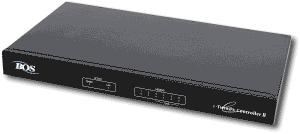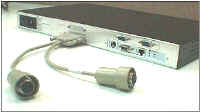|
|
|
BOSaNOVA e-Twinax Controller (eTwinax, e-Twin@x)
Frequently Asked Questions -
Printing |
|
 
 |

e-Twinax
Controller
Printing Knowledge Base
SCS Printers
-
What are the *WSCST objects that I see under library BOSCSTLIB in my
AS/400?
-
Why do some printers go to FAILED status on e-Twinax Controller
Configurator?
-
Some jobs that were printed before in CPI 15 are now being printed
in CPI 10. How can I fix it?
-
Some jobs that were printed before in CPI 10 are now being printed
in CPI 15. How can I fix it?
-
PC printer attached to the Twinax Terminal/Emulation doesn't print
correctly. How can I fix it?
-
The Printer Writer in AS/400 goes into END status while printing.
What is the reason?
-
How can I see the printer status like out-of-paper, or off-line on
AS/400 the same way I used to see status from the directly attached
printer?
-
I set Printer status support to Host but Printer Writer in AS/400
goes into END status after when printer is out of paper, or button
Cancel or off-line was pressed. What is the reason?
-
Why do I see in e-Twinax Controller configurator that my printer is
in Offline status while I know it is Online?
-
I have a print job that includes Magnum code. First page is printed
OK, but from the second page I get garbage. What can I do?
-
There are messages in the e-Twinax Controller log starting with "SCS
Parameter error on printer..." Or "SCS Code error on printer...".
What is the reason?
-
Why does my printer skip some lines at the beginning of each job?
-
Sometimes the printer session will not print, even though the
printer device is on-line. Why does this happen and how can I fix
it?
-
How can I accelerate
printing speed?
IPDS Printers
-
Why do all IPDS printers stay in END status on AS/400 even though
they are Online?
-
What are the *PSFCFG objects that I see under library BOSCSTLIB in
my AS/400?
-
My printer starts printing but after few pages stops printing and
goes to Failed status in e-Twinax configurator. How can I fix it?
-
My printer starts printing but skips labels and lines. How can I fix
it?
-
Why did e-Twinax Controller create the IPDS printer with Advanced
Function Printing parameter at the host set to *Yes, while it is set
to *No when printer is connected directly to AS/400?
-
After I've installed on my AS/400 OS/400 V4R4, I get a message that
I must license PSF/400 order to use IPDS printer. What is the
reason?
-
How can I see the printer status like out-of-paper, or off-line on
AS/400 the same way I used to see status from the directly attached
printer?
-
I received the "Error occurred on (TCP/IP, 4(UNKNOWN))" error
message in the Diagnostic Log. What does it mean?
-
I received the "Port number allowed only for local devices or LAN
printers" error message in the Diagnostic Log. What does it mean?
-
I have an IPDS printer and I send it duplex print jobs, i.e. on both
sides of the page. Most of the jobs are printed OK, but a few jobs
are not. How can I fix this?
SCS Printer Questions
- What are the *WSCST objects that I see under library BOSCSTLIB in
my AS/400?
TN5250e supports only 3812-1 printer model, thus in
order to support Twinax legacy printers such as: 5224, 5225, 4234, 4214
and more, e-Twinax Controller creates printer sessions with Workstation
Customization Object (*WSCST) for each printer model. For example:
BSCST5224 object supports 5224 printer. These objects are created when
controller first verifies the connection to each host and you confirm
the request to update CST objects.
Back to Top
- Why do some printers go to FAILED status on e-Twinax Controller
Configurator?
Usually it happens because this printer name is
already in use. Try to solve the conflict and then reset printer
session. If there is no conflict, but status is FAILED, the
reason may be that somehow host locked one of the printer jobs. In this
case, even if you delete the printer's device description on host, it
still appears to host as if this printer is in use. In this case only
IPL will clear out the printer.
Back to Top
- Some jobs that were printed before in CPI 15 are
now being printed in CPI 10. How can I fix it?
It is probably because in the print file associated
with this job the Font Id parameter (FONT) is set to *DEVD. You need to
change it to *CPI. . For example:
CHGPRTF FILE(QSYSPRT)
FONT(*CPI)
Back to Top
- Some jobs that were printed before in CPI 10 are
now being printed in CPI 15. How can I fix it?
It is probably because in the print file associated
with this job the Degree of page rotation parameter (PAGRTT) is set to
*COR. You need to change it to 0. For example:
CHGPRTF FILE(QSYSPRT)
PAGRTT (0)
Back to Top
- PC printer attached to the Twinax
Terminal/Emulation doesn't print correctly. How can I fix it?
In this case you should use Host Print Transform
instead of Customized Objects. In order to do it, do the following:
Set
Use Host Print Transform to Yes in the
Change Printer Device screen in the e-Twinax Controller
Configurator. Host Print Transform is an AS/400 process that converts a
print job originally written in EBCDIC code into an ASCII data stream
that contains both the print job contents and the printer commands. You
must then select the appropriate PC printer from list. This will allow
you to get printouts created by the AS/400 for that specific printer.
Back to Top
- The Printer Writer in AS/400 goes into END status
while printing. What is the reason?
It is because you do not have the latest PTFs that
fix these TN5250e printer session problems installed and applied on
AS/400. Verify your system from e-Twinax configurator to get the PTFs
that are missing. Also check that each PTF that is installed is also
applied.
Back to Top
- How can I see the printer status like out-of-paper,
or off-line on AS/400 the same way I used to see status from the
directly attached printer?
Change SCS Printer status support under Advanced parameters in e-Twinax Controller configurator to 1 (Host)
instead of 0 (Local). Also, check that all appropriate PTFs required for
the TN5250e printer support are installed and applied on the AS/400.
Back to Top
- I set Printer status support to Host
but Printer Writer in AS/400 goes into END status after when
printer is out of paper, or button Cancel or off-line was pressed. What
is the reason?
You need to have the following PTF installed and
applied on the AS/400:
V4R1: PTF SF57180
V4R2: PTF SF56882
V4R3: PTF SF53489
Back to Top
- Why do I see in e-Twinax Controller configurator
that my printer is in Offline status while I know it is Online?
Some printers send erroneous status messages to the
e-Twinax Controller. This causes the Controller to stop the print job.
Set the status support setting in e-Twinax Controller
configurator to Ignore offline. If other erroneous messages are
received, set the status support setting to Ignore all.
Back to Top
- I have a print job that includes Magnum code. First
page is printed OK, but from the second page I get garbage. What can I
do?
This happens because the SCS commands that are sent
at the beginning of each page "breaks" the Magnum code. There is a way
to avoid sending SCS commands at the beginning of each page, but for
this you need to do the following:
1. Install a special PTF from IBM:
V4R1: SF56212
V4R2: SF56217
V4R3: SF56298
Back to Top
- There are messages in the e-Twinax Controller log
starting with "SCS Parameter error on printer..." Or "SCS Code error on
printer...". What is the reason?
This happens because you explicitly
defined a printer model in the
e-Twinax configurator, which does not match to the actually connected Twinax printer. This message appears because the
printer does not support one or more SCS commands being sent to it by
the AS/400. Change the printer model to the correct one.
Back to Top
- Why does my printer skip some lines at the
beginning of each job?
Check the e-Twinax Controller log for the messages
starting with: "SCS Parameter error on printer..." Or "SCS Code error on
printer...". This message appears because the printer does not support
one or more SCS commands being sent to it by the AS/400. In this case, a
faulty SCS command may cause the lost of some data to print. Change the
printer model to the correct one
Back to Top
- Sometimes the printer session will not print, even
though the printer device is on-line. Why does this happen and how can I
fix it?
Use the following procedure:
- First of all, go to the "Work with Output
Queue" screen of that printer and check status. If it is RLS it
means that writer is ended - it should be RLS/WTR.
- Start the writer using the command
STRPRTWTR .
If the status remains RLS, it means that there was an error with the
printer session connection.
- Go to the e-Twinax Configurator and enable log
for that session. Then select Suspend to stop the session and
Resume
to restart it.
- Go to the Diagnostic Log screen of
e-Twinax
Configurator. After a while you will see the printer session startup
sequence, like in following sample:
000:53:56 S10 Connecting session 10 to address
100.200.180.200 port 23.
000:53:56 S10 R FFFD27
000:53:56 S10 S FFFB27
000:53:56 S10 R FFFD18FFFA270103-49424D5253454544-8033331D66058004
000:53:56 S10 S FFFB18FFFA270003-49424D5253454544-8033331D66058004
000:53:57 S10 R FFFA1801FFF0
000:53:57 S10 S FFFA180049424D2D-333831322D31FFF0-
000:53:57 S10 R FFFD19
000:53:57 S10 S FFFB19
000:53:57 S10 R FFFB19
000:53:57 S10 S FFFD19
000:53:57 S10 R FFFD00
000:53:57 S10 S FFFB00
000:53:58 S10 R FFFB00
000:53:58 S10 S FFFD00
000:53:58 S10 R 004912A090000560-060020C0003D0000-F8F9F4F0E2F1F0F2
000:53:58 Error occurred on PRTSES3 (TCP/IP, 5039(ENOTCONN))
Look for a string beginning with the '004912A090000560' sequence. It
contains important information about how the session succeeded to
connect. If this string contains the 'C9F9F0F2' sequence as well, it
means that the connection was successful. In other cases it will contain
a string like 'F8F9F4F0'. It is an EBCDIC error code - 8940 in this
case. You can see this in the table below -
"8940 - automatic configuration failed or not allowed". The following is the table of possible error codes:
2702 - device description not found
2703 - controller description
not found
2777 - damaged device description
8901 - device not
varied on
8902 - device not available
8903 - device not valid
for session
8906 - session initiation failed
8907 - session
failure
8910 - controller not valid for session
8916 - no
matching device found
8917 - not authorized to object
8918 -
job canceled
8920 - object partially damaged
8921 -
communications error
8922 - negative response received
8923 -
start-up record built incorrectly
8925 - creation of device
failed
8928 - change of device failed
8929 - vary on or vary
off failed
8930 - message queue does not exist
8934 - start-up for S/36 WSF
received
8935 - session rejected
8936 - security failure on
session attempt
8940 - automatic configuration failed or not
allowed
Some of these codes show a problem which can be fixed immediately,
others may require IBM technical support intervention. In case of an
8930 error, just change message queue name to an existing one. In other
cases try to allow the controller to attempt an auto-recovery session -
set auto-recovery time-out to 3 minutes. If this doesn't help, reset the
session (if you use HTTP Configurator - first check 'Force delete on
recovery' check box). If the problem still happens, change session name
to the new one, because in some cases the session name is occupied by
Telnet server and cannot be re-used until IPL.
Back to Top
- How can I accelerate printing speed?
Sometimes when the e-Twinax Controller is connected
to the AS/400 using a slow connection (such as dial-out or 64 KB Frame
Relay) and the AS/400 printouts are created using a special AS/400
application (like Optio) the printing process is slow. In these cases,
each page contains about 50 KB of data and printing can take up to 40-50
seconds per page.
Starting with e-Twinax version 2.22.00 there is special parameter in the Advanced
Parameters list called "Optimize printer speed". Set it to 1 (Yes) to
speed up printing. It may cause slight degradation in terminal response
time when large print jobs are being processed.
Back to Top
IPDS Printer Questions
- Why do all IPDS printers stay in END status on
AS/400 even though they are Online?
IPDS printers are configured and started
automatically once e-Twinax Controller identifies an online IPDS
printer. This is done with the use of RMTCMD (Remote Command) server &
SVRMAP (Server mapper) server. Check if those servers are in Listen mode
by performing the following steps:
1. Enter the command
NETSTAT <Enter>, then 3 <Enter>. Look for lines containing as-rmtcmd and
as-svrmap strings.
2. If there are no such
lines, enter the following commands:
STRHOSTSVR *SVRMAP
and
STRHOSTSVR *RMTCMD
3. If the lines are
present, but diagnostic log shows that it is unable to run Remote
Command, close these servers first using command ENDHOSTSVR
<server-name>, then start them again.
4. Verify that the User
ID and Password you entered for this system are still valid and has
*IOSYSCFG profile.
Back to Top
- What are the *PSFCFG objects that I see under
library BOSCSTLIB in my AS/400?
These objects are created by the e-Twinax
Controller for each IPDS printer. The object includes parameters, which
PSF/400 uses when it builds the IPDS data streams.
Back to Top
- My printer starts printing but after few pages
stops printing and goes to Failed status in e-Twinax configurator. How
can I fix it?
The reason is probably because the Page Size
Control (PAGSIZCTL) parameter in PSFCFG object of this printer is set to
*NO. Change it to *YES by setting Page size control in IPDS
additional parameters in e-Twinax Controller configurator to 1 and
reset printer.
Back to Top
- My printer starts printing but skips labels and
lines. How can I fix it?
The reason is probably because the Page Size
Control (PAGSIZCTL) parameter in PSFCFG object of this printer is set to
*NO. Change it to *YES by setting Page size control in IPDS
additional parameters in e-Twinax Controller configurator to 1 and
reset printer.
Back to Top
- Why did e-Twinax Controller create the IPDS printer
with Advanced Function Printing parameter at the host set to *Yes, while
it is set to *No when printer is connected directly to AS/400?
When the printer was connected directly to AS/400
as a Twinax IPDS printer, by default Advanced Function Printing (AFP)
parameter is set to *NO. When the printer connects through e-Twinax
Controller, it is created as an IP IPDS printer. In this connection
type, you can only create the device with AFP parameter set to *YES.
This actually an AS/400 restriction, but even though, the most
"primitive" IPDS printer such as 4224 model 01 manages to work fine
through e-Twinax Controller.
Back to Top
- After I've
connected an IPDS Printer to the e-Twinax Controller I
get a message that I must license PSF/400 order to use IPDS printer.
What is the reason?
From V4R4 the licensing
of PSF/400 is
verified and you get a grace period of 70 days to do that.
Until V4R4 you had to license PSF/400,
but it was not checked by the operating system.
Back to Top
- How can I see the printer status like out-of-paper,
or off-line on AS/400 the same way I used to see status from the
directly attached printer?
IPDS status messaging on host is fully supported by
e-Twinax Controller. This includes: Offline, End of paper, Cancel print
and Paper jam. You must set the following in e-Twinax Controller
configurator in order to get printer error messages on host:
1. Set IPDS Printer
status support in Advanced parameters to 1 (Host).
2. Set Host printer
messages mode in IPDS printer additional parameters to 2
(*INQ).
3. Reset the printer.
Back to Top
- I received the "Error occurred on (TCP/IP,
4(UNKNOWN))" error message in the Diagnostic Log. What does it mean?
This message and corrected "Error occurred on
(TCP/IP, 4(time-out))" means that there was no connection request to the
IPDS printer session from the AS/400 or SECURIT-e Server in connection
time-out. There is most likely a communication problem - the AS/400 or
the SECURIT-e Server is unable to connect to the IPDS printer port
(default is range 5000-5056). You should enable these ports in Proxy or
use other enabled ports - change the IPDS base port in advanced options.
Back to Top
- I received the "Port number allowed only for local
devices or LAN printers" error message in the Diagnostic Log. What does
it mean?
This message is generated if the same printer
session name is used for both an SCS printer and an IPDS printer. The
e-Twinax Controller checks that the device exists and then changes the
device description - IP address and port number. But these parameters
are incorrect for an SCS printer device description. You must delete the
old device description. We suggest using the Reset Printer option in the
Configurator.
Back to Top
- I have an IPDS printer and I send it duplex print
jobs, i.e. on both sides of the page. Most of the jobs are printed OK,
but a few jobs are not. How can I fix this?
Most likely, the 'Printer device type' parameter in
the print file of these problematic jobs is set to *SCS instead of to *AFPDS.
Since the Twinax IPDS printers appear in the AS/400 as TCP/IP IPDS
printers, the AFP utility is building the data stream that is sent to
the printer, so it must build an AFPDS data stream instead of an SCS
data stream. In order to modify this parameter, enter the following
command:
CHGPRTF FILE(print_file_name) DEVTYPE(*AFPDS)
Back to Top
Back to
e-Twinax Controller main page
Information Request
Form
eTwinax Controller -
Twinax-over-IP
eTwinax Information Request -
New 062218
 |
|
Rear
view of e-TwinST@r Controller
with RJ45 unit attached |
The e-Twinax Controller
now has an optional model that includes a built-in unit featuring 8 (or 16) RJ45
sockets. Twinax devices working over CAT5 lines are connected directly
to the Controller, saving the cost of an active star hub and
eliminating the need for power sources and additional space in the
communications closet, as well as the extra set-up and maintenance
time. The RJ45 Ports of this option operate just as a Twinax
port with an RJ45 Balun attached to it.
If you need to connect more Twinax Devices than the number of physical
ports on an e-Twinax Controller, please read the explanation in the next
section. The e-Twinax Controller model must be able to support the
number of devices you need to connect.
The e-TwinStar
(4800 Series) is available in models with support for 8, 16, 28,
56 or 112 Twinax addresses/devices. The 4800 Series is fully
upgradeable from one model to the next allowing for growth from 8
to a full 112 device support. The 4800 Series
also supports connection of the 8-Port Twinax Brick as the
e-Twinax 4600 Series as well as the IBM 8-Port Twinax Brick
from your existing Internal Twinax Workstation Controllers.
Upgrades are made by
simple entering a new software key in the configuration section of the
e-Twinax. You can upgrade remote locations by accessing the upgrade
portion of the configuration over your WAN. Upgrading is done
while the controller is in full operation. There is no need to
have those users connected to it brought down. This eliminates
the need other controllers have to bring them down while increasing
their device capacity or adding options.
Explanation of Device Support
for the eTwinax and RJ45 Ports of e-Twinax Controller
As with the standard AS/400 8-port "Twinax Brick" from the
Twinax Workstation Controller, each Host Port (Twinax or RJ45) of the
e-Twinax will support up to a maximum number of 7 device addresses
(0, 1, 2, 3, 4, 5, 6), up to the maximum number of devices the particular
model controller will support. This convention holds true to all
Twinax or RJ45 Host Ports of S/36, S/38, AS/400, iSeries and all IBM,
Decision Data, I-O, Idea, and Perle Remote Controllers except for the very
old 5251-12 and 5294 controllers that only supported a maximum of 4
addresses per Host Port.
For example, an IBM 5394-01B Controller has three Twinax Host
Ports. Three ports with 7 devices each would total 21. The
5394-01B only supports 16. You can distribute those 16 device
addresses across those three ports however you see fit. That could
be 7 on the first port, 7 on the second port and 2 on the third
port. You could also have 6, 6 and 4 or any other combination that
totals 16 device addresses with a maximum of 7 on any one port.
Another example is the 4616 (Twinax Host Ports) and 4816 (RJ45 Host
Ports) of the e-Twinax Controllers. Both of these models will
support 16 Twinax addresses/devices but only have 8 physical
ports. Using the same logic as with the 5394-01B example, you
can connect devices to ANY of these 8 ports as long as the total number of
addresses used is 16 or less. For example you could use the same 7,
7, and 2 on the first three Host Ports as with the 5394. Being these
models have 8 Host Ports, you could also put 2 devices on each port for a
total of 16. You could also have 4, 4, 4 and 4 on four of the 8 Host
Ports or any other combination that totals 16 device addresses with a
maximum of 7 on any one of the 8 ports.
If you need to connect more physical devices than the number of ports
you have two options.
First, you can "cable-through"
your Twinax devices from one to the next using actual
Twinax
cables. Using this method you can connect up to 7 devices to a
single Host Port. If you are using multiple session terminals, the
number of physical devices would be less as each Host Port will only
support 7 addresses.
Second, you
can add a
Twinax-to-RJ45
Active Star Hub such as the
Gemini
Express Active Star Hub to your setup. These Active Star Hubs connect
to one of the controllers Host Ports either by Twinax Cable or Category 5
(CAT5) cable, and expand the single port to 7 RJ45 ports corresponding
with the device addresses available on that port of 0, 1, 2, 3, 4, 5, and
6. This is the same whether the e-Twinax Controller has Twinax Host
Ports or RJ45 Host Ports. In this implementation each Twinax Device
would be required to have a Twinax-to-RJ45 Balun on it to allow connection
with a CAT5 cable.
The RJ45
Host Ports of the e-Twinax Controller are operationally the same as a
Twinax Host Port with an RJ45 Balun attached to it.uest - New 040416
|




